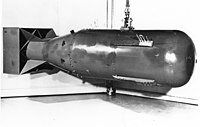
Photo from wikipedia
Most existing models for assessing the releases of engineered nanomaterials (ENMs) into the environment are based on the assumption that ENMs remain in their pristine forms during their whole life… Click to show full abstract
Most existing models for assessing the releases of engineered nanomaterials (ENMs) into the environment are based on the assumption that ENMs remain in their pristine forms during their whole life cycle. It is known, however, that this is not always the case as ENMs are often embedded into solid matrices during manufacturing and can undergo physical or chemical transformations during their life cycle, e.g. upon release to wastewater. In this work, we present a method for systematically assessing the forms in which nano-Ag and nano-TiO2 flow through their life cycle (i.e. production, manufacturing, use and disposal) to their points of release to air, soil and surface water. Input data on the forms of released ENMs were probability distributions based on peer-reviewed literature. Release data were incorporated into a probabilistic material flow analysis model to quantify the proportions of ENMs in product-embedded, matrix-embedded, pristine, transformed and dissolved forms in all technical and environmental compartments into which they flow, at the European scale. Releases of nano-Ag to surface water and soil were modelled to occur primarily in transformed forms (Q25 and Q75 of 34-58% and 78-86%, respectively, with means of 53% and 82%), while releases to air were mostly in pristine and matrix-embedded forms (38-46% and 36-44%, respectively, with means of 42% and 40%). In contrast, nano-TiO2 releases to air, soil and water were estimated to be predominantly in pristine form (75-85%, 90-95%, 96-98%, respectively, with means of 80%, 91% and 97%). The distributions of ENM releases between forms developed here will improve the representativeness and appropriateness of input data for environmental fate modelling and risk assessment of ENMs.
Journal Title: Environmental pollution
Year Published: 2018
Link to full text (if available)
Share on Social Media: Sign Up to like & get
recommendations!